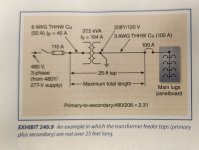[Schematic of 37.5 kVA 480D : 208Y/120V transformer and OCPD/conductor sizing under 240.21(B)(3).]
That image is clearly on point for this discussion, what's the source?
The image certainly supports the idea that your interpretation is industry standard. Which I don't believe I've expressed an opinion on; my position has simply been that this interpretation, industry standard or not, does not provide the same level of protection as 240.21(B)(2), which makes it a poor interpretation, in my opinion.
This image does bring to mind another way to illustrate the problem I see. Let's replace the transformer with a 240D : 415Y/240V transformer, also 37.5 kVA. That's a little exotic, but something you might find in a data center that was converted from a prior use which already had an adequately sized 240V delta service.
Then the rated primary current is 90A, and the rated secondary current is 52A. So we could use a 225A primary OCPD, 90A primary conductors, and 60A secondary conductors to a 60A main breaker panelboard. If the primary-to-secondary voltage ratio in 240.21(B)(3) is 240/415, that complies: 225 * (240/415) / 3 = 43.4A.
Now consider the case that the secondary panelboard just supplies L-N 2-wire loads, and only loads on one phase are powered on (the others are off). As a thought experiment, we could just delete the transformer and refeed that particular L-N 2-wire circuit from two of the formerly primary L-L conductors. If we do that, none of the currents in the system change at all (lots of implementation details change, as the circuit no longer has a grounded conductor). And if the tap rules are consistent, the new arrangement should satisfy 240.21(B)(2). But it doesn't: 225/3 = 75A, while we have only 60A conductors.
This discrepancy arises because it is more appropriate to use 240:240 as the primary-to-secondary voltage ratio on this 240D : 415Y/240V transformer. That makes 240.21(B)(3) exactly equivalent to 240.21(B)(2).
Cheers, Wayne

